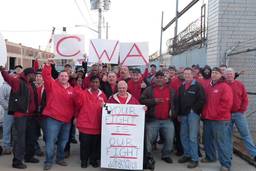A week ago, we celebrated Earth Day. A flurry of newspaper articles and TV specials recognized the occasion. But yesterday, Workers’ Memorial Day, it was difficult to find anyone remembering those who have died on the job. While Earth Day receives mass attention, environmental, health and safety issues in the workplace were barely acknowledged.
This doesn’t mean that Americans have nothing to worry about in their workplaces.
When the federal Occupational Health and Safety Administration (OSHA) was created in 1970, 14,000 workers died every year on the job. Now only 4,340 die on the job each year, and another 50,000 workers die annually from occupational diseases related to chemical exposure, severe working condition, black lungs, etc. Workplace injuries are down from 10.9 incidents per 100 workers in 1972 to less than 4 per 100 in 2009.
Clearly, OSHA has made tremendous strides in workplace safety. But the agency, part of the labor department, is still extraordinarily hamstrung as it tries to enforce current workplace safety laws.
There are only 2,218 inspectors at both the federal and state level who inspect workplace safety to cover 7.5 million workplaces employing more than 130 million workers. That’s one inspector for every 57,984 workers. At this rate, OSHA can inspect a workplace on average once every 129 years and state OSHA inspectors could inspect one every 67 years.
For a country the size of the United States, health and safety experts say you need at least 12,000 inspectors to properly do your job.
When OSHA does find a problem, its penalties are quite easy to ignore. Since 1970, there have only been 84 cases prosecuted of willful violation of safety rules that resulted in a worker death. During this time, more than 360,000 workers died on the job. The penalty for wrongfully killing a worker on the job is only 6 months. The maximum penalty for a major safety violation is a mere $7,000.
To put this in pespective, chasing a wild burro onto federal land is a felony that can land you in jail for one year.
Few prosecutions want to waste expensive time on trails that aren’t going to result in jail time or major fines. Thus we have seen only 84 prosecutions for wrongful deaths on the job in OSHA’s 40-year history, despite more than hundreds of thousands of deaths on the job.
In contrast, tough penalties exist for environmental problems. In 2010 alone, there were 346 criminal prosecutions under federal environmental laws, resulting in 72 years of jail time for the perpetrators and $41 million levied in fines against. In just one year, the EPA has had more prosecutions, convictions, fines and jail time sentenced than in the entire history of OSHA.
Likewise, compared to the EPA, OSHA budget and staff is miniscule. OSHA employs approximately 2,300 people, while the EPA has a staff of over 17,000. In 2010, OSHA had a budget of $558.6 million, while the EPA had a budget nearly twenty times its size at $10.3 billion.
Why is it that the EPA is an organization that is adequately funded and can vigorously enforce its mandate to protect community health, while OSHA is not able to do a similar job but in the workplace? The reason is that there is a much larger social movement to protect the environment than there is to protect workers in the workplace. Earth Day is something that everybody knows about, while you only hear about Worker’s Memorial Day in union circles.
Most college-educated liberals who work in office spaces rarely, if ever, have to deal with situations in which people could potentially be killed on the job. But for the 4,000 people a year who are killed on the job, it’s a big issue. As long as health and safety is an issue that is only talked about at gatherings of union activists, organizations like OSHA will remain too small and workers will continue dying on the job without major penalties for the corporations who are OK with deadly working conditions.








